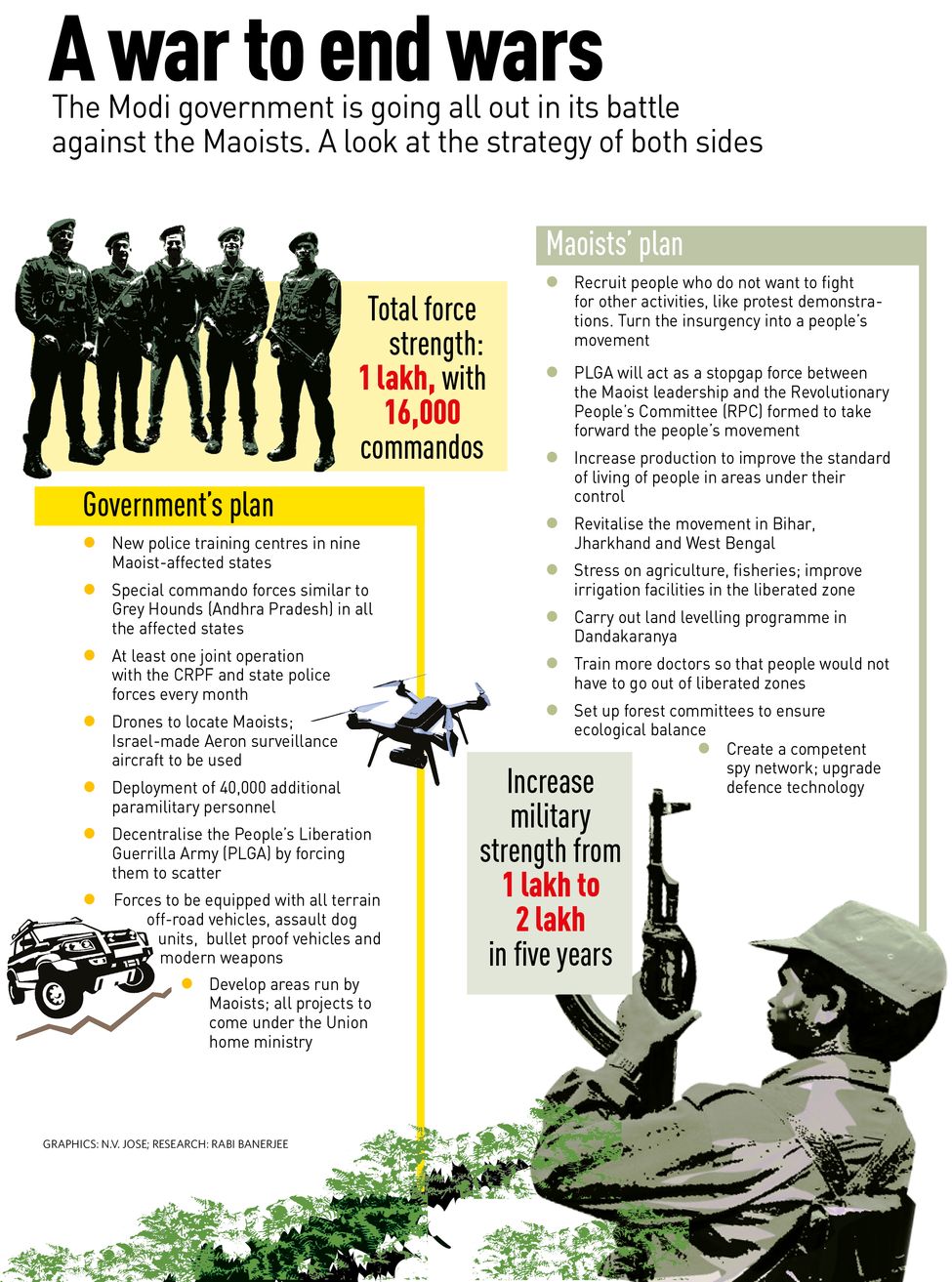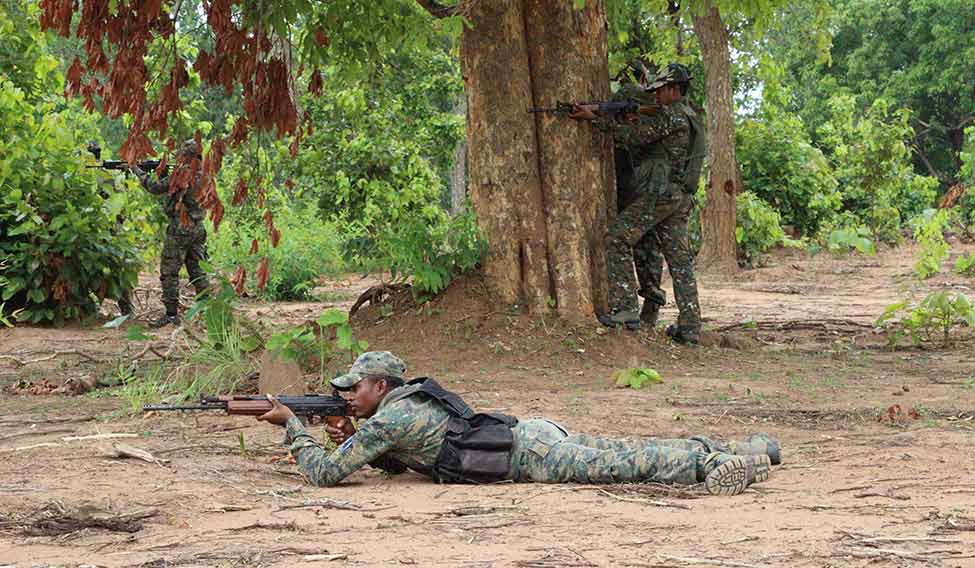Burkapal is a hamlet in Chhattisgarh’s Sukma district, lying on the proposed 72km-road to a liberated zone of the Maoists. Although the construction of the road, which would give security forces access to the liberated zone, started in 2010, the progress has been slow, especially after Maoists attacked a contingent of the Central Reserve Police Force, which was in charge of guarding the construction workers, almost immediately after work began. In one of the deadliest attacks in the history of the CRPF, 76 jawans were killed by the ultras on April 6, 2010. The Maoists threatened more attacks if the government went ahead with the project.
But the situation changed after the National Democratic Alliance government headed by Narendra Modi took charge at the Centre three years ago. The Modi government intensified its campaign against the Maoists and even conducted four air operations. It also restarted the road project. The Maoists retaliated on March 11, 2017, killing 12 CRPF jawans at Bheji, where the road started.
On April 24, the Maoists struck again, targeting CRPF jawans who were overseeing the road work at Burkapal. It was unbearably hot that day, with the temperature touching 42 degrees Celsius and the jawans had been marching since morning, covering 20km by noon. Hungry, thirsty and tired, most of them had sat down for lunch, leaving their weapons at a safe place. A while later, they saw a group of 100 women who looked like tribals approaching them, carrying firewood. Being a routine sight, the jawans did not pay much attention. However, within seconds, the women put the firewood down, pulled out their guns, and arrows equipped with improvised explosive devices (IEDs), and attacked them. Around 200 male guerrillas provided them support. In no time, 26 jawans were dead, dealing another blow to India’s attempt to tackle the Maoist menace. Two Maoists—Anil alias Deva, who was the commander of platoon 24, and Ravi, who headed the Cherla local area squad—were killed by the jawans. The dead body of another Maoist, Mukkam Barman, was found a few days later.
According to Maoist documents accessed by THE WEEK, their numbers in the nine states, which are their strongholds, have reached 1,00,000. Nearly 40 per cent of them are women. Women are now recruited as militia members, commanders, supply squad members, party committee members, weapon repairers, military instructors, doctors, tailors and guards of senior central committee members. “Women played a crucial role in the recent attacks carried out by us. They could use light machine guns and arrows with IED,” said the document.
 Helping hand: Union Home Minister Rajnath Singh meets a CRPF jawan a day after the Burkapal attack | PTI
Helping hand: Union Home Minister Rajnath Singh meets a CRPF jawan a day after the Burkapal attack | PTI
Following the Burkapal ambush, Union Home Minister Rajnath Singh convened a meeting of security experts and chief ministers of Chhattisgarh, Jharkhand, Odisha, West Bengal, Bihar, Maharashtra, Telangana, Uttar Pradesh, Madhya Pradesh and Andhra Pradesh on May 8. It was decided to give a “free hand” to security officers in anti-Maoist operations. The government has also brought development work in the affected areas under the Union home ministry.
The CRPF has subsequently moved ten battalions of its elite Combat Battalion for Resolute Action (CoBRA) to Chhattisgarh. Each battalion has around 1,000 commandos. The force has also shifted the operational headquarters of its central zone to Raipur from Kolkata. Although there was a demand to get the support of the Army and the Air Force in anti-Maoist operations, finally it was decided that the Army would keep away for the time being. The Air Force has set up a station in Chhattisgarh with ten Mi-17 helicopters and five aircraft.
Wing Commander S.S. Birdi, defence spokesperson for the eastern region, said the Air Force was being used for evacuation and retaliation as and when required. “For instance, a year and a half ago when Maoists fired at a pilot, we had to retaliate, which dealt a serious blow to the ultras,” he said. CRPF Director General R.R. Bhatnagar confirmed to THE WEEK that the anti-Maoist forces were not taking any help from the Army. “The Air Force is required to evacuate in tough situations and for security purposes,” he said.
A senior officer at the eastern region headquarters of the Army said the operations of the Air Force depended on the requirements of the special forces. “What goes beyond standard operating procedures are classified information and will not be shared with us. It will remain within the ministries only.”
The CRPF and the Chhattisgarh Special Task Force have been on the offensive after the April 24 attacks, “killing many Maoists” and “wiping out” a section of its leadership. “We have made major inroads into the Maoist zone. The jawans are carrying out strong attacks,” said Bhatnagar. Since April 24, the CRPF has conducted 121 special operations in Sukma district alone, targeting 14 major military bases of the Maoists like Karigundem, Minapa, Kasalpara, Milampalli and Tokenpalli. Bijapur witnessed 59 special operations and Dantewada, 40. The three districts—Sukma, Bijapur and Dantewada—form the heart of the red-corridor in Chhattisgarh.
“A big congregation of Maoists was reported in Puvarti and Chinnaborkel areas which fall on the border of Sukma and Bijapur areas. Based on this intelligence input, on the nights of May 12 and 14, fierce encounters took place. Early reports indicate that Maoists have sustained major reversals in these encounters,” said a report by the home ministry. Bhatnagar said many senior commanders of the Maoists were neutralised in the attacks.
Since the Burkapal attack, 89 Maoists have been apprehended and 31 guns, 4,447 rounds of assorted ammunition, 291kg of explosives, two grenades, 87 IEDs and 5,130 detonators were confiscated.
D.M. Awasthi, special director general of the Chhattisgarh Police in charge of anti-Maoist operations, said his team managed to attack Maoists in their bastions for the first time. “Never ever in the last five decades could we enter places we have entered this time. We have given them major blows in the areas where they have military bases.”
Awasthi said the attacks were supported by air power. “Whenever our forces were attacked, the Air Force retaliated. In one of the attacks, we entered the liberated zone through Bijapur. We hit the Number 1 military battalion, which had around 150 guerrillas. The report we received said most of them died in the attack. Earlier we used to fight them. Now, for the first time, we have attacked them. And we will continue with the momentum and reach our target, where the senior leaders are hiding.” He said the forces had all required information about the movements of the senior leadership of the Maoists, including their secretary, Ganapathy. “They are inside the Dandakaranya area spread across Chhattisgarh, Andhra Pradesh and Odisha. They are shifting bases from time to time. But we know where they are going.”
For instance, the chief of the Dandakaranya zonal committee, Gajarala Ravi, is now moving in and around Telangana, according to a security official from Chhattisgarh.
Jagan, chief of the Maoist Adhikar Committee (a village-level political organisation of the Maoists), said the security forces were forcing people to vacate village after village and burning down their houses. “They are doing combing operations, setting houses on fire to kill Maoists. This is cruelty at its peak,” said Jagan, in a message. He said between May 12 and May 16 alone, around 90 huts were set on fire.
The Maoists, meanwhile, are trying to spread to other regions. Awasthi said the ultras were moving into forest areas in south India. The Union home ministry has sent a report to the Tamil Nadu, Karnataka and Kerala governments that Maoists are in the process of setting up four squads in the Western Ghats. “All such squads would be combat type and they would avenge the death of Maoist leaders Kuppu Devaraj and Ajitha [who were killed in an encounter with the Kerala Police last November],” said the report.
The home ministry report confirmed heavy Maoist presence in “Wayanad, Kozhikode, Malappuram, Nilambur and Palakkad in Kerala and Gudalur in Tamil Nadu and adjoining areas in Karnataka.” The area is a tri-junction like Dandakaranya, and as tough geographically. Unless curbed immediately, the region could develop into another major Maoist stronghold like Dandakaranya.
“The state governments will have to take it seriously,” said a senior officer of the Chhattisgarh STF, who believes that many senior Maoist leaders have already fled to the jungles in the southern tri-junction. “They will have to make sure that the jungles of Kerala, Karnataka and Tamil Nadu border do not turn into Maoist dens.”









